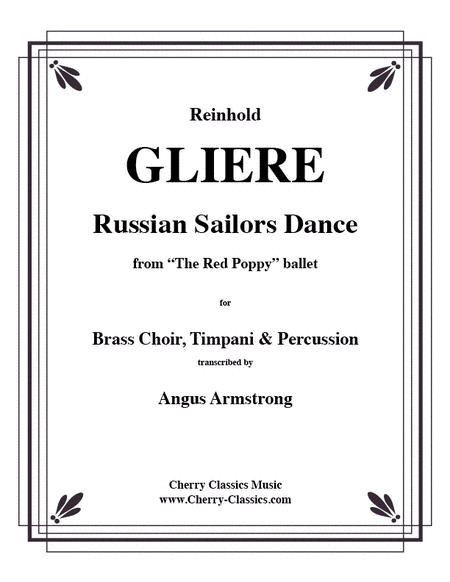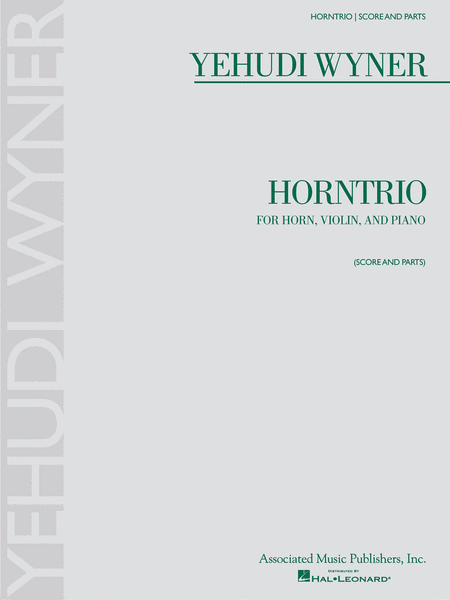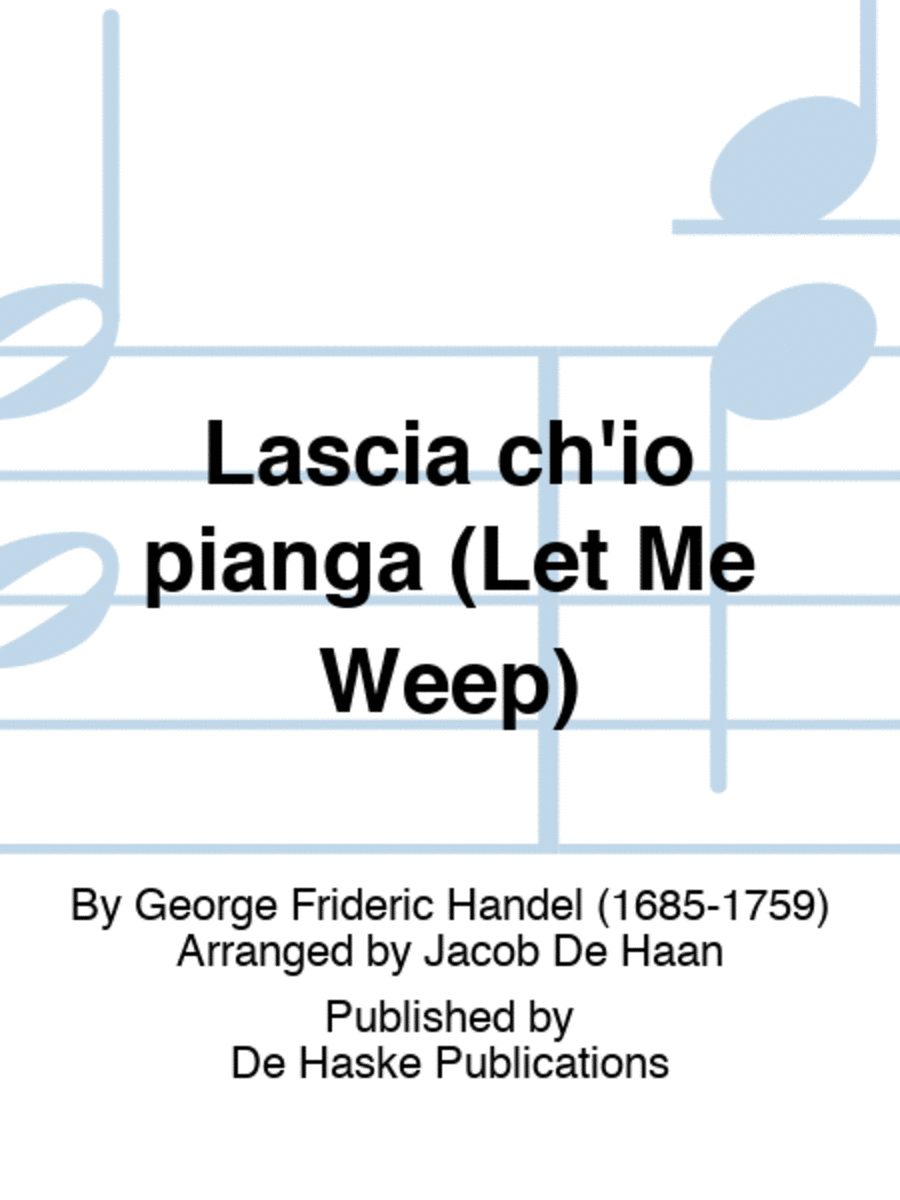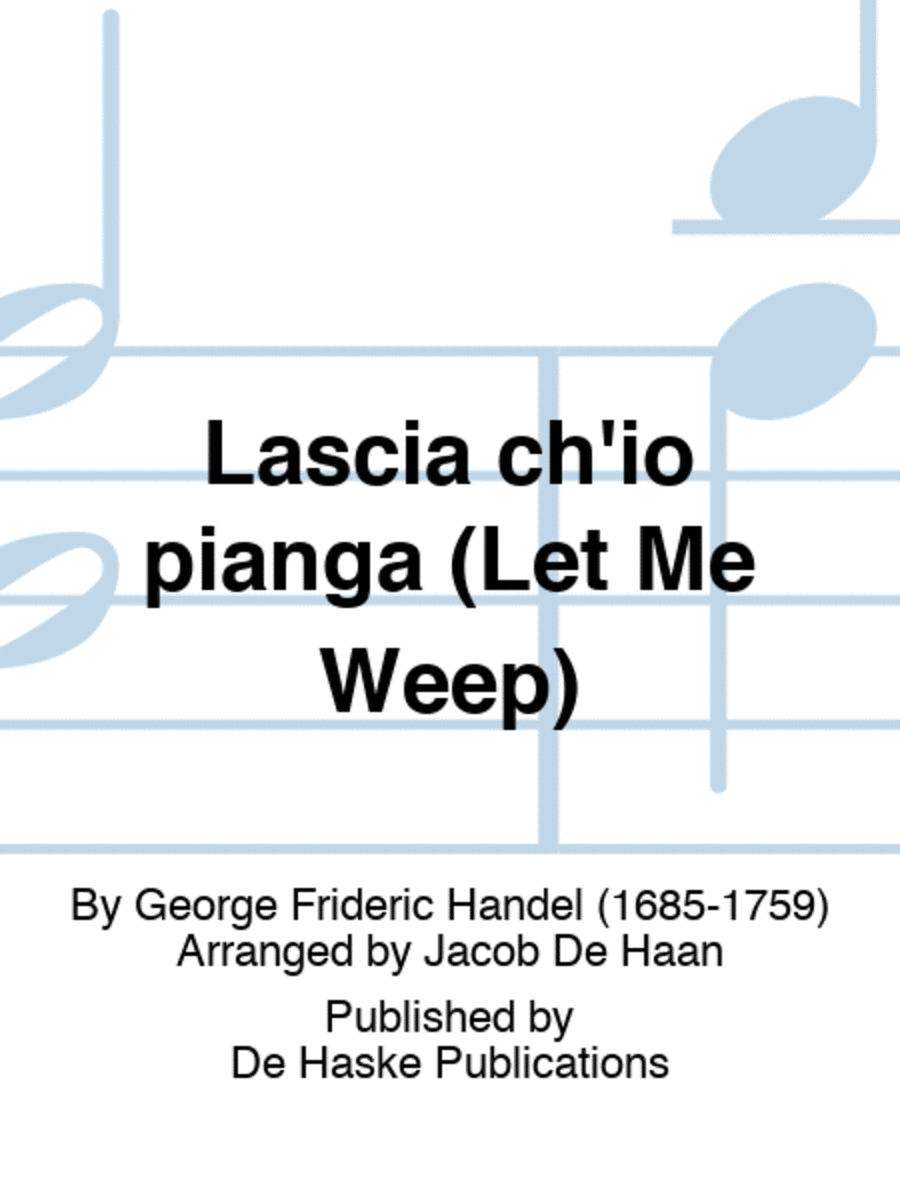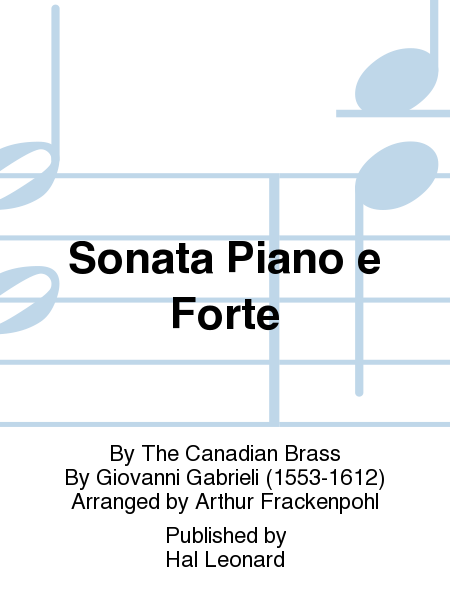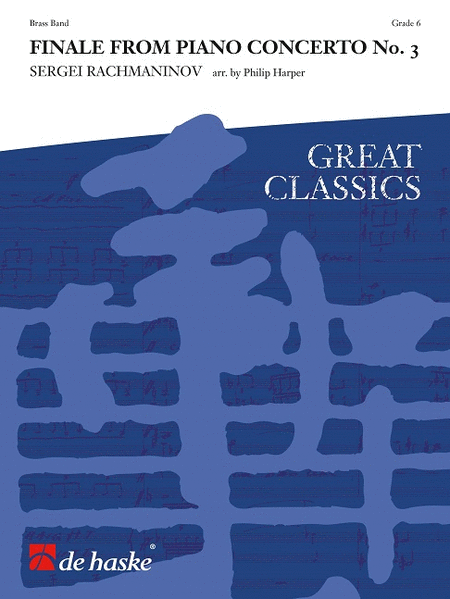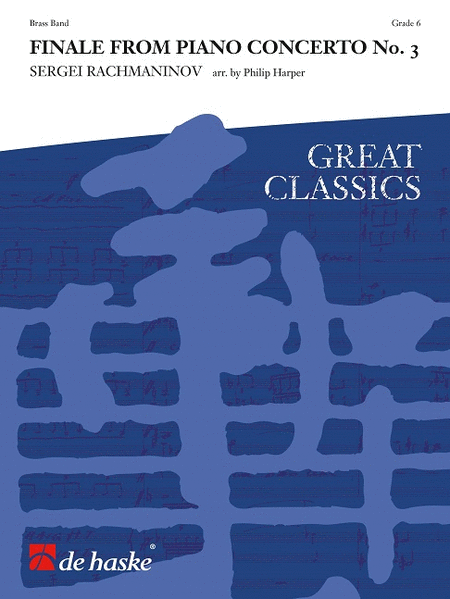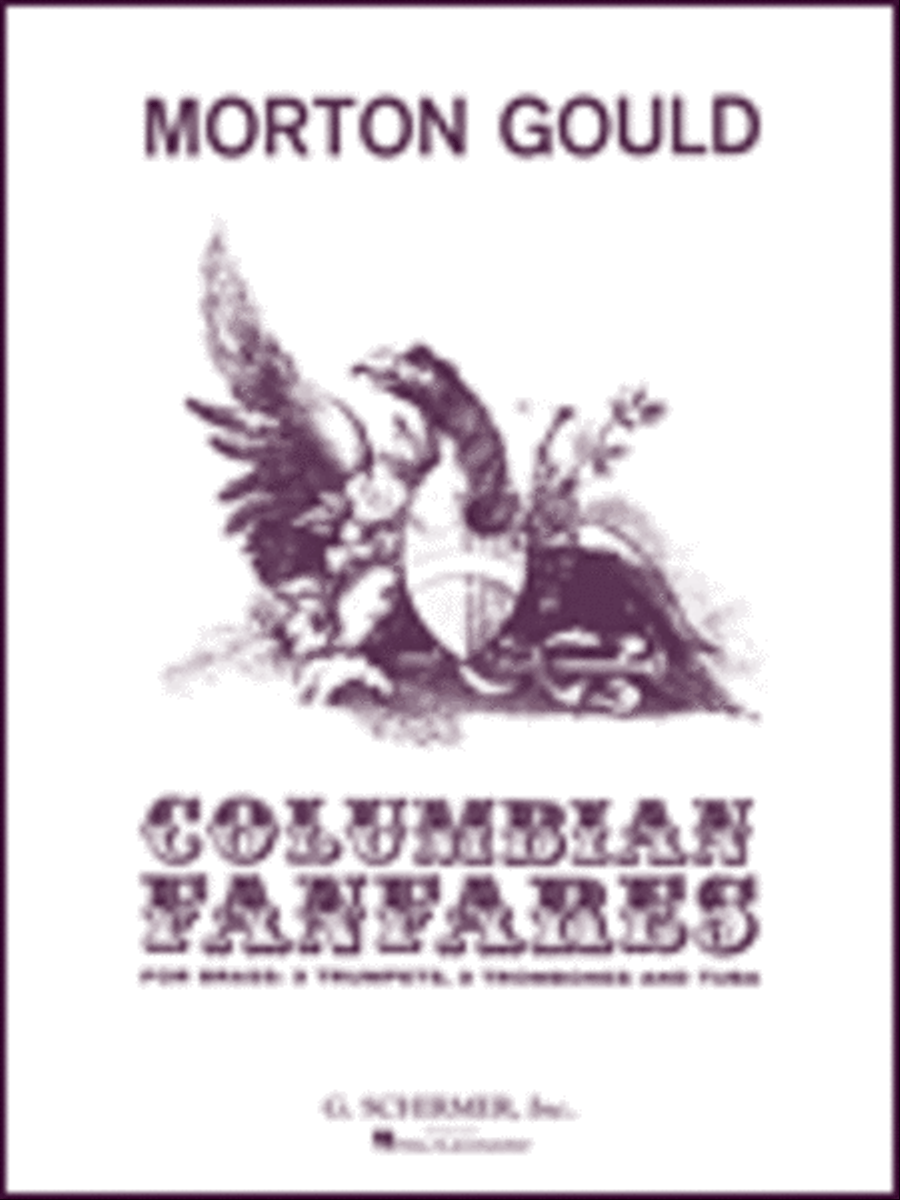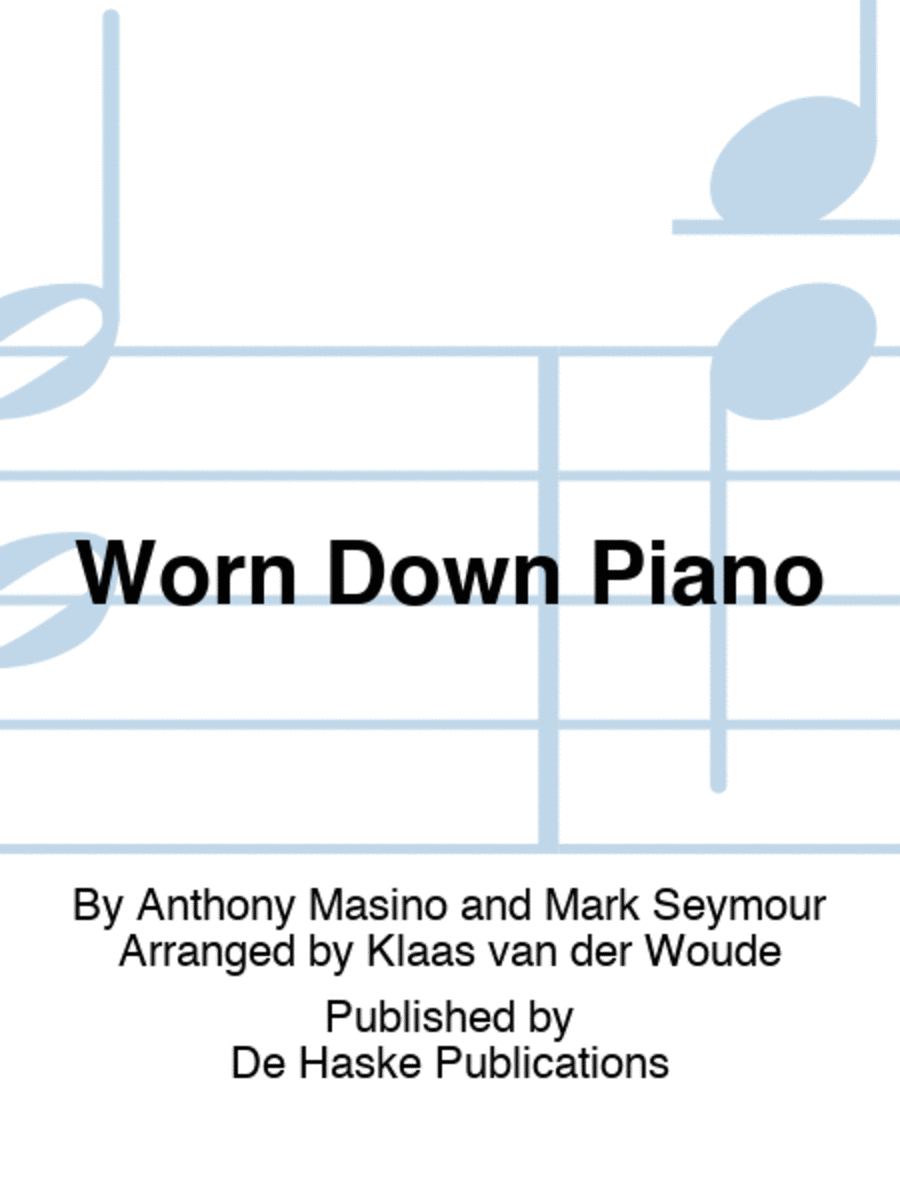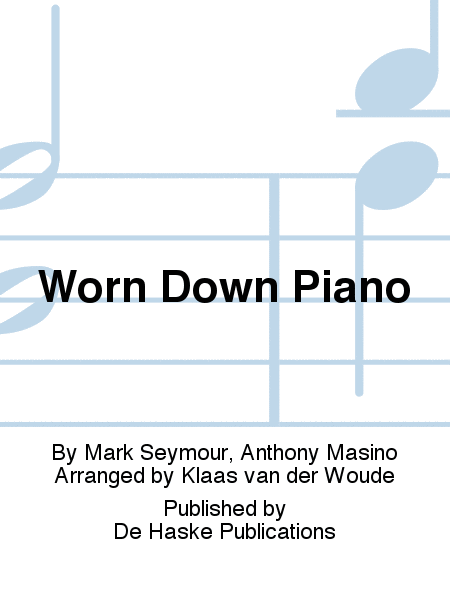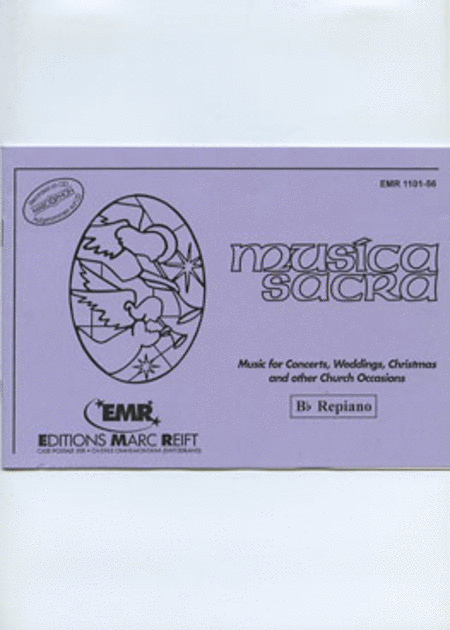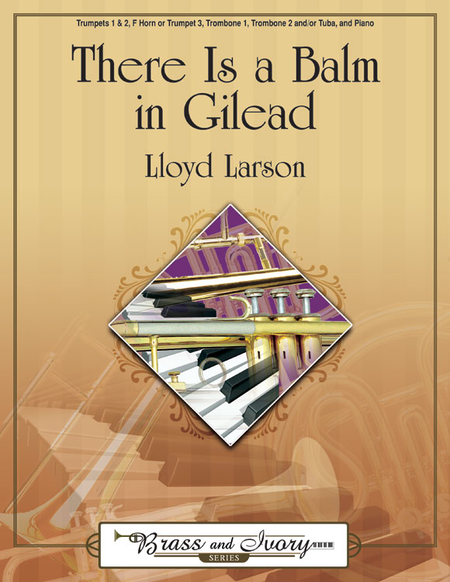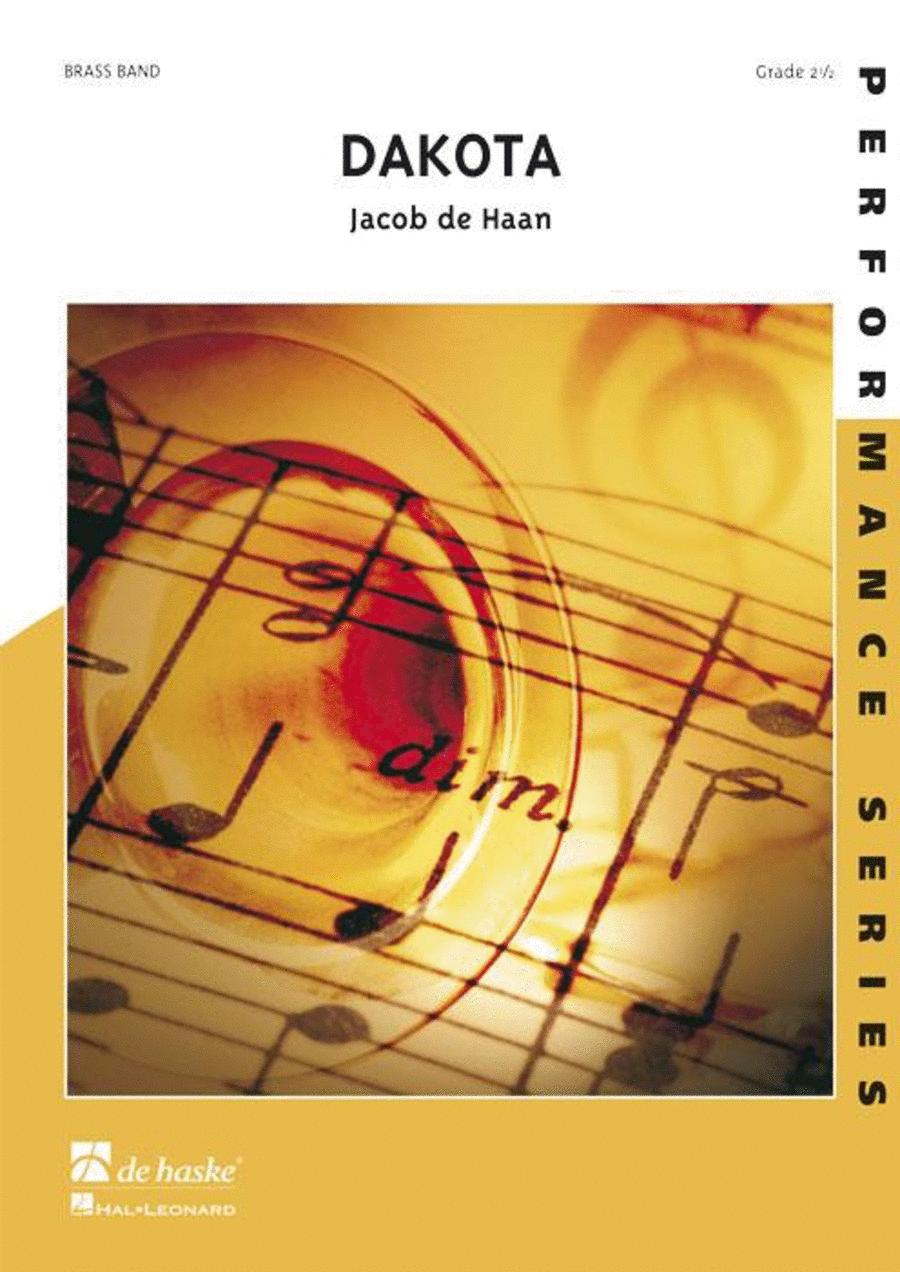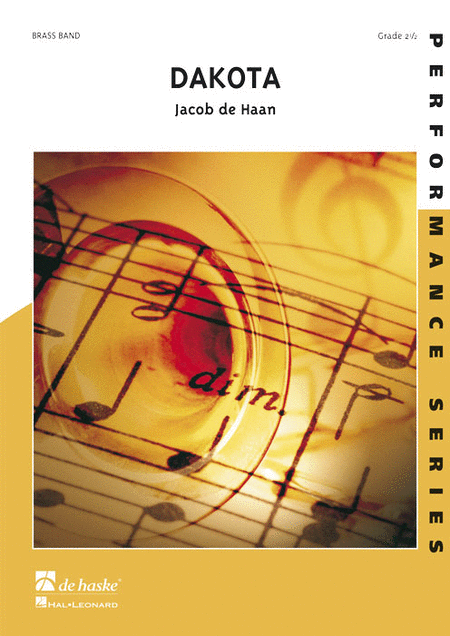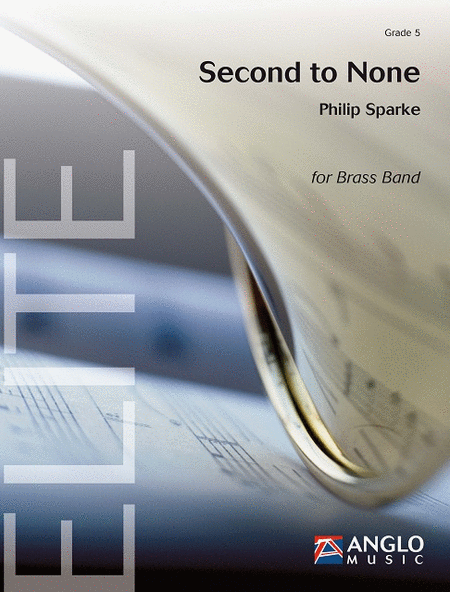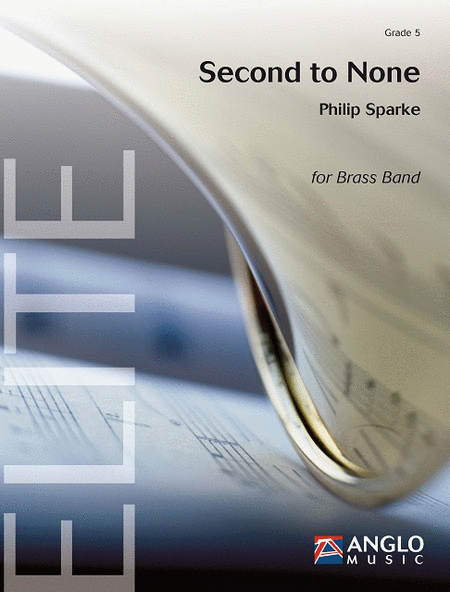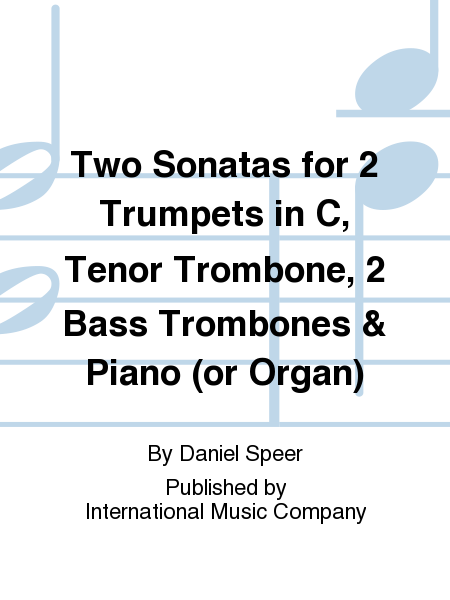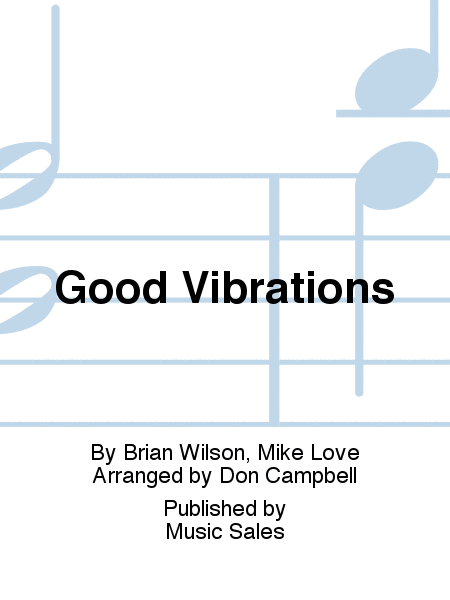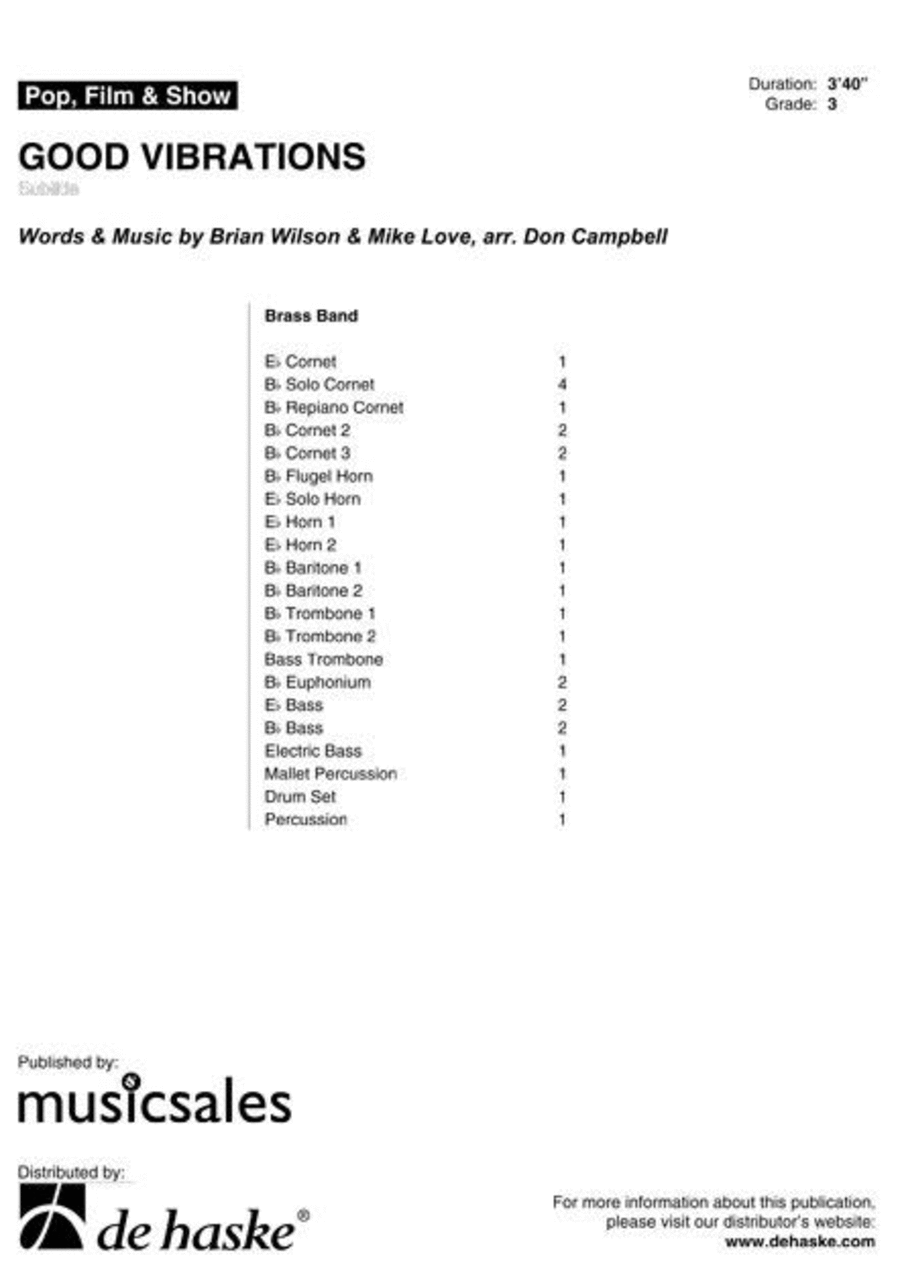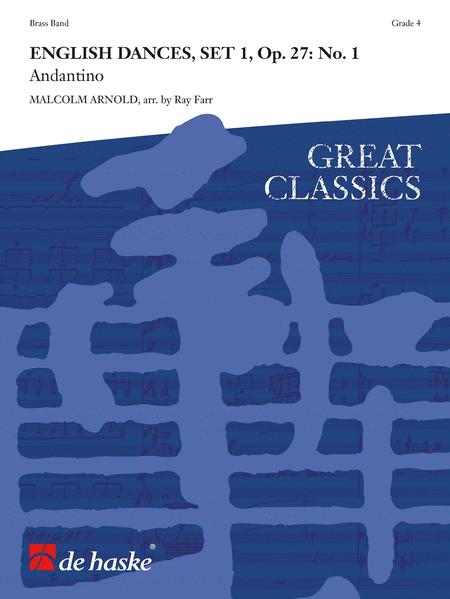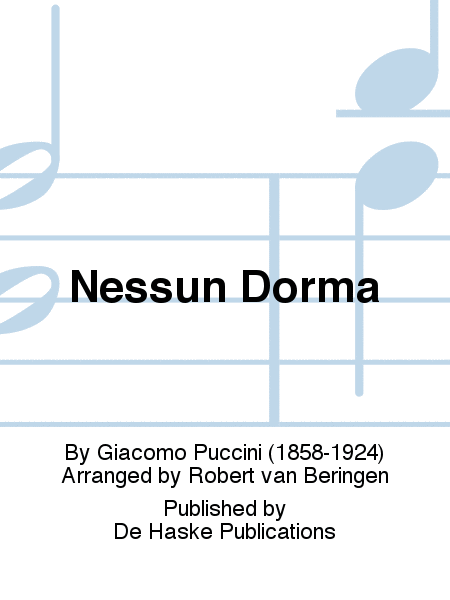|
| Russian Sailors' Dance Brass Ensemble
Ensemble de cuivres [Conducteur]
Cherry Classics
By Reinhold Moritzovich Gliere (1874-1956). Arranged by Angus Armstrong. For Bra...(+)
By Reinhold Moritzovich
Gliere (1874-1956).
Arranged by Angus
Armstrong. For Brass
Ensemble and Percussion.
Russian 19th Century.
Advanced. Full Score and
Parts. Published by
Cherry Classics
$32.50 - Voir plus => AcheterDélais: 2 to 3 weeks | | | |
| Horntrio (Horn, Violin, Piano)
Ensemble de cuivres [Conducteur et Parties séparées]
Associated
For Horn, Violin, and Piano. By Yehudi Wyner. Brass Ensemble. Size 9x12 inches. ...(+)
For Horn, Violin, and
Piano. By Yehudi Wyner.
Brass Ensemble. Size 9x12
inches. Published by
Associated Music
Publishers, Inc.
$35.00 - Voir plus => AcheterDélais: 24 hours - In Stock | | | |
| Lascia ch'io pianga (Let Me Weep)
Ensemble de cuivres [Conducteur et Parties séparées] - Facile
De Haske Publications
Brass Band - Grade 2 SKU: BT.DHP-1043545-030 From the opera Rinaldo va...(+)
Brass Band - Grade 2
SKU:
BT.DHP-1043545-030
From the opera Rinaldo
van Georg Friedrich
Händel. Composed
by George Frideric
Handel. Arranged by Jacob
De Haan. Your Favorite
Classics. Set (Score &
Parts). Composed 2004. De
Haske Publications #DHP
1043545-030. Published by
De Haske Publications
(BT.DHP-1043545-030).
Let Me Weep
(‘Lascia
ch’io
pianga’) is an
aria from Handel’s
opera
‘Rinaldo’.
According to reports he
composed the music for
the complete opera in
just 14 days, using many
melodies from earlier
works. The melody of this
wonderful aria is known
all over the world and
this arrangement by Jacob
de Haan retains all the
passion of the original.
Lascia
ch’io pianga (Let
Me Weep) is een aria
uit de opera
Rinaldo. Aaron
Hill schreef het
scenario, waarna Giacomo
Rossi de poëtische
teksten schreef. Georg
Friedrich Händel
voorzag deze later van
muziek. Hij zou demuziek
in veertien dagen hebben
gecomponeerd en veel
melodieën uit eerdere
werken hebben gebruikt.
In 1711 werd
Rinaldo voor het
eerst uitgevoerd. De
melodie van deze
prachtige aria is
wereldwijd bekend en komt
uitstekendtot haar recht
in dit arrangement van
Jacob de
Haan.
Let Me
Weep - im Original
Laschia ch’io
pianga - stammt aus
der Oper Rinaldo,
deren Musik Georg
Friedrich Händel
angeblich in weniger als
vierzehn Tagen
geschrieben hat! Er
verwendete für diese
märchenhafte Oper
viele Melodien aus
älteren Werken. Die
Melodie dieser
prächtigen Arie ist
weltweit bekannt und
beliebt - so ist mit
Jacob de Haans
hervorragender
Bearbeitung für Brass
Band ein Publikumserfolg
garantiert!
Lascia
ch’io pianga
est un air extrait de
Rinaldo, premier
opéra londonien de
Georg Friedrich Haendel
sur un livret de Giacomo
Rossi d’après
un scénario
d’Aaron Hill.
Quinze jours de travail
suffirent Haendel pour
achever la partition. Le
résultat est en
réalité une vaste
adaptation de plusieurs
œuvres
antérieures.
Rinaldo a
été créé
Londres en 1711. Les
décors féeriques et
chevaleresques étaient
éblouissants pour
l’époque, et
c’est sans doute
pour cela que
l’œuvre fut
plébiscitée par le
public.Dans le
merveilleux jardin du
palais enchanté
d’Armide
(l’alliée
d’Argante, le
rival de Rinaldo),
Almirène (la promise
de Rinaldo) pleure sa
captivité dansson air
Lascia ch’io
pianga, l’un
des plus beaux
qu’Haendel ait
écrits. Cette sublime
mélodie, célèbre
dans le monde entier, a
été arrangée
avec finesse et justesse
par Jacob de Haan. $78.95 - Voir plus => AcheterDélais: 2 to 3 weeks | | | |
| Lascia ch'io pianga (Let Me Weep)
Ensemble de cuivres [Conducteur] - Facile
De Haske Publications
Brass Band - Grade 2 SKU: BT.DHP-1043545-130 From the opera Rinaldo va...(+)
Brass Band - Grade 2
SKU:
BT.DHP-1043545-130
From the opera Rinaldo
van Georg Friedrich
Händel. Composed
by George Frideric
Handel. Arranged by Jacob
De Haan. Your Favorite
Classics. Score Only.
Composed 2004. De Haske
Publications #DHP
1043545-130. Published by
De Haske Publications
(BT.DHP-1043545-130).
Let Me Weep
(‘Lascia
ch’io
pianga’) is an
aria from Handel’s
opera
‘Rinaldo’.
According to reports he
composed the music for
the complete opera in
just 14 days, using many
melodies from earlier
works. The melody of this
wonderful aria is known
all over the world and
this arrangement by Jacob
de Haan retains all the
passion of the original.
Lascia
ch’io pianga (Let
Me Weep) is een aria
uit de opera
Rinaldo. Aaron
Hill schreef het
scenario, waarna Giacomo
Rossi de poëtische
teksten schreef. Georg
Friedrich Händel
voorzag deze later van
muziek. Hij zou demuziek
in veertien dagen hebben
gecomponeerd en veel
melodieën uit eerdere
werken hebben gebruikt.
In 1711 werd
Rinaldo voor het
eerst uitgevoerd. De
melodie van deze
prachtige aria is
wereldwijd bekend en komt
uitstekendtot haar recht
in dit arrangement van
Jacob de
Haan.
Let Me
Weep - im Original
Laschia ch’io
pianga - stammt aus
der Oper Rinaldo,
deren Musik Georg
Friedrich Händel
angeblich in weniger als
vierzehn Tagen
geschrieben hat! Er
verwendete für diese
märchenhafte Oper
viele Melodien aus
älteren Werken. Die
Melodie dieser
prächtigen Arie ist
weltweit bekannt und
beliebt - so ist mit
Jacob de Haans
hervorragender
Bearbeitung für Brass
Band ein Publikumserfolg
garantiert!
Lascia
ch’io pianga
est un air extrait de
Rinaldo, premier
opéra londonien de
Georg Friedrich Haendel
sur un livret de Giacomo
Rossi d’après
un scénario
d’Aaron Hill.
Quinze jours de travail
suffirent Haendel pour
achever la partition. Le
résultat est en
réalité une vaste
adaptation de plusieurs
œuvres
antérieures.
Rinaldo a
été créé
Londres en 1711. Les
décors féeriques et
chevaleresques étaient
éblouissants pour
l’époque, et
c’est sans doute
pour cela que
l’œuvre fut
plébiscitée par le
public.Dans le
merveilleux jardin du
palais enchanté
d’Armide
(l’alliée
d’Argante, le
rival de Rinaldo),
Almirène (la promise
de Rinaldo) pleure sa
captivité dansson air
Lascia ch’io
pianga, l’un
des plus beaux
qu’Haendel ait
écrits. Cette sublime
mélodie, célèbre
dans le monde entier, a
été arrangée
avec finesse et justesse
par Jacob de Haan. $19.95 - Voir plus => AcheterDélais: 2 to 3 weeks | | | |
| Giovanni Gabrieli: Sonata Piano e Forte
Ensemble de cuivres [Conducteur et Parties séparées]
Hal Leonard
Score and Parts. Performed by The Canadian Brass. By Giovanni Gabrieli. Arranged...(+)
Score and Parts.
Performed by The Canadian
Brass. By Giovanni
Gabrieli. Arranged by
Arthur Frackenpohl. Brass
Ensemble. Size 9x12
inches. Published by Hal
Leonard Corporation.
$29.99 - Voir plus => AcheterDélais: 24 hours - In Stock | | | |
| Finale from Piano Concerto N°3
Ensemble de cuivres [Conducteur] - Intermédiaire/avancé
De Haske Publications
Brass Band - Grade 6 SKU: BT.DHP-1145600-130 Composed by Sergei Rachmanin...(+)
Brass Band - Grade 6
SKU:
BT.DHP-1145600-130
Composed by Sergei
Rachmaninoff. Arranged by
Philip Harper. Great
Classics. Classical.
Score Only. Composed
2014. De Haske
Publications #DHP
1145600-130. Published by
De Haske Publications
(BT.DHP-1145600-130).
English. Philip
Harper has created a
fabulous transcription of
the energetic third
movement of
Rachmaninoff’s
Piano concerto No. 3 in D
minor. This movement is
comprised of variations
on a theme from the first
movement of the concerto.
The final notes would
become
Rachmaninoff’s
musical signature. An
outstanding and very
spectacular title!
Philip Harper
heeft hiermee een
magnifieke transcriptie
van het energieke derde
deel van Rachmaninovs
pianoconcert nr. 3 in
d-klein gecreëerd. Dit
deel bestaat uit
variaties op een thema
uit het eerste deel van
het concert. De laatste
noten zouden Rachmaninovs
muzikale handtekening
worden. Een geweldig,
spectaculair stuk!
Philip Harper
schuf eine fantastische
Bearbeitung des
schwungvollen 3. Satzes
aus Rachmaninows
Klavierkonzert Nr. 3 in
d-Moll. Dieser Satz
besteht aus Variationen
über ein Thema aus dem
1. Satz des Konzertes.
Die Schlusstöne
sollten Rachmaninows
musikalisches
Erkennungszeichen werden.
Ein
außergewöhnlicher,
fantastischer Titel!
Philip Harper a
créé une
transcription formidable
de
l’énergétiqu
e troisième mouvement
du Concerto pour piano
no.3 en ré mineur
de Rachmaninoff. Ce
mouvement comprend des
variations sur un
thème du premier
mouvement de ce concerto.
Les dernières notes
deviendront la signature
musicale de Rachmaninoff.
Un morceau exceptionnel
et très spectaculaire
! $25.95 - Voir plus => AcheterDélais: 2 to 3 weeks | | | |
| Finale from Piano Concerto N°3
Ensemble de cuivres - Intermédiaire/avancé
De Haske Publications
Brass Band - Grade 6 SKU: BT.DHP-1145600-030 Composed by Sergei Rachmanin...(+)
Brass Band - Grade 6
SKU:
BT.DHP-1145600-030
Composed by Sergei
Rachmaninoff. Arranged by
Philip Harper. Great
Classics. Classical. Set
(Score and Parts).
Composed 2014. De Haske
Publications #DHP
1145600-030. Published by
De Haske Publications
(BT.DHP-1145600-030).
English. Philip
Harper has created a
fabulous transcription of
the energetic third
movement of
Rachmaninoffâ??s Piano
concerto No. 3 in D
minor. This movement is
comprised of variations
on a theme from the first
movement of the concerto.
The final notes would
become Rachmaninoffâ??s
musical signature. An
outstanding and very
spectacular title!
Philip Harper
heeft hiermee een
magnifieke transcriptie
van het energieke derde
deel van Rachmaninovs
pianoconcert nr. 3 in
d-klein gecreëerd. Dit
deel bestaat uit
variaties op een thema
uit het eerste deel van
het concert. De laatste
noten zouden Rachmaninovs
muzikale handtekening
worden. Een geweldig,
spectaculair stuk!
Philip Harper
schuf eine fantastische
Bearbeitung des
schwungvollen 3. Satzes
aus Rachmaninows
Klavierkonzert Nr. 3 in
d-Moll. Dieser Satz
besteht aus Variationen
über ein Thema aus dem
1. Satz des Konzertes.
Die Schlusstöne
sollten Rachmaninows
musikalisches
Erkennungszeichen werden.
Ein
au�ergewöhnlicher,
fantastischer Titel!
Philip Harper a
créé une
transcription formidable
de lâ??énergétique
troisième mouvement du
Concerto pour piano
no.3 en ré mineur
de Rachmaninoff. Ce
mouvement comprend des
variations sur un
thème du premier
mouvement de ce concerto.
Les dernières notes
deviendront la signature
musicale de Rachmaninoff.
Un morceau exceptionnel
et très spectaculaire
! $125.95 - Voir plus => AcheterDélais: 2 to 3 weeks | | | |
| Columbian Fanfares for Brass
Ensemble de cuivres
Schirmer
Score and Parts. By Morton Gould. Brass Ensemble. Size 9x12 inches. Published by...(+)
Score and Parts. By
Morton Gould. Brass
Ensemble. Size 9x12
inches. Published by G.
Schirmer, Inc.
$25.00 - Voir plus => AcheterDélais: 24 hours - In Stock | | | |
| Worn Down Piano
Ensemble de cuivres [Conducteur et Parties séparées] - Facile
De Haske Publications
Brass Band - Grade 3 SKU: BT.DHP-1023227-030 Composed by Anthony Masino a...(+)
Brass Band - Grade 3
SKU:
BT.DHP-1023227-030
Composed by Anthony
Masino and Mark Seymour.
Arranged by Klaas van der
Woude. De Haske Pop
Collection. Pop & Rock.
Set (Score & Parts).
Composed 2002. De Haske
Publications #DHP
1023227-030. Published by
De Haske Publications
(BT.DHP-1023227-030).
Worn Down Piano
was a huge hit for the
Mark & Clark Band in
1977. This arrangement by
Klaas van der Woude makes
an entertaining piece
with its tonal contrasts
working exceptionally
well for brass band.
Worn Down
Piano war ein
großer Hit für die
Mark & Clark Band im
Jahre 1977. Klaas van der
Woude nahm sich des
Titels erneut an und
machte daraus ein
schönes Arrangement
für Brass Band. $78.95 - Voir plus => AcheterDélais: 2 to 3 weeks | | | |
| Worn Down Piano
Ensemble de cuivres [Conducteur] - Facile
De Haske Publications
Brass Band - Grade 3 SKU: BT.DHP-1023227-130 Composed by Anthony Masino a...(+)
Brass Band - Grade 3
SKU:
BT.DHP-1023227-130
Composed by Anthony
Masino and Mark Seymour.
Arranged by Klaas van der
Woude. De Haske Pop
Collection. Pop & Rock.
Score Only. Composed
2002. De Haske
Publications #DHP
1023227-130. Published by
De Haske Publications
(BT.DHP-1023227-130).
Worn Down Piano
was a huge hit for the
Mark & Clark Band in
1977. This arrangement by
Klaas van der Woude makes
an entertaining piece
with its tonal contrasts
working exceptionally
well for brass band.
Worn Down
Piano war ein
großer Hit für die
Mark & Clark Band im
Jahre 1977. Klaas van der
Woude nahm sich des
Titels erneut an und
machte daraus ein
schönes Arrangement
für Brass Band. $31.95 - Voir plus => AcheterDélais: 2 to 3 weeks | | | |
| Musica Sacra - Bb Repiano
Ensemble de cuivres - Facile
Editions Marc Reift (Swiss import)
By Various. Brass Band. For Bb Repiano. Swiss import. Sacred Music. Level: Grade...(+)
By Various. Brass Band.
For Bb Repiano. Swiss
import. Sacred Music.
Level: Grade 2+. Part.
Published by Editions
Marc Reift. (EMR 1101-56)
$8.95 - Voir plus => AcheterDélais: 3 to 4 weeks | | | |
| There Is a Balm in Gilead
Ensemble de cuivres
Lorenz Publishing Company
By Lloyd Larson. Instrumental ensemble (brass). For Trumpets 1 and 2, F Horn or ...(+)
By Lloyd Larson.
Instrumental ensemble
(brass). For Trumpets 1
and 2, F Horn or Trumpet
3, Trombone 1, Trombone 2
and/or Tuba, and Piano.
Brass and Ivory Series.
Published by Lorenz
Publishing Company
$22.95 - Voir plus => AcheterDélais: 1 to 2 weeks | | | |
| Dakota
Ensemble de cuivres [Conducteur] - Facile
De Haske Publications
Brass Band - Grade 2.5 SKU: BT.DHP-1023116-130 Indian Sketches. Co...(+)
Brass Band - Grade 2.5
SKU:
BT.DHP-1023116-130
Indian Sketches.
Composed by Jacob De
Haan. Performance Series.
Concert Piece. Score
Only. Composed 2002. De
Haske Publications #DHP
1023116-130. Published by
De Haske Publications
(BT.DHP-1023116-130).
The Dakota (or
Sioux) Indians from the
American states of North
and South Dakota form the
central figures in this
composition. The work
consists of five
movements in which the
culture and history of
these Indians have been
portrayed through musical
paintings by making use
of an old South Dakota
Indian melody.
Die Dakota- (oder
Sioux-) Indianer der
amerikanischen Staaten
Nord- und Süd-Dakota
sind die zentralen
Figuren in dieser
Komposition. Das Werk
besteht aus fünf
Sätzen, in welchen die
Kultur und die Geschichte
dieser Indianer
dargestellt werden. In
einigen Sätzen
verwendete Jacob de Haan
eine alte indianische
Melodie aus
Süd-Dakota.1. The
Great Spirit
(‘Der Große
Geist’)Die Kultur
der Dakota-Indianer war
der irdischen und der
spirituellen Welt
verbunden. Sie glaubten,
dass der Große Geist
die Erde schuf, indem er
einen schwarzen Ball auf
das Wasser warf und dann
aus einem zweiten Ball
alles Lebendige schuf.2.
Buffalo Hunting
(‘Büffeljagdâ�
�™)Auf einen
mächtigenBüffel
zuzureiten erforderte
Können und Mut. Die
Männer ergriffen
jedoch mit Freude die
Chance, sich selbst auf
der Jagd zu beweisen.3.
Smoking the Pipe
(‘Die Pfeife
rauchen’)Die
Pfeife galt als
Friedenssymbol und wurde
unter Männern und
Stämmen benutzt. Die
Pfeife rauchen besiegelte
einen Bund des Vertrauens
und heilige, Pfeife
rauchende Männer
nahmen so Kontakt mit dem
Großen Geist auf.4.
The Ghost Dance
(‘Der
Geistertanz’)Diese
r religiöse Tanz der
verlorenen Hoffnung
basierte auf Gebet, Tanz
und Gesang. Im Jahre 1890
engagierten die Soldaten
Geistertänzer an einem
Ort namens Wounded
Knee.5. Pilgrims at
Wounded Knee
(‘Pilger am Wounded
Knee‘)Die
Tragödie von Wounded
Knee ist sehr schmerzhaft
für die Indianer.
Viele pilgern noch immer
zu der heiligen, vom Wind
verwehten Hügelspitze,
auf der so viele
Unschuldige den Tod
fanden.
Les
Indiens Dakota (Sioux)
des États
américains du Dakota
du Nord et du Dakota du
Sud sont au centre de
cette fresque musicale,
dans laquelle Jacob de
Haan dépeint certains
aspects de leur culture
et de leur histoire. Dans
plusieurs mouvements de
cette œuvre, le
compositeur a
intégré une
mélodie indienne
ancienne provenant du
Dakota du Sud.1. Le
Grand Esprit : la
culture des Indiens
Dakota était liée
la terre et au monde des
esprits. Dans leurs
croyances, le Grand
Esprit avait créé
la terre en jetant une
balle noire dans
l’eau, puis il
prit une deuxième
balle et créa les
êtres vivants. 2.
La chasse au bison
: courir bride abattue
vers un bisonvigoureux
nécessitait beaucoup
d’adresse et de
courage. Pourtant, les
hommes attendaient
impatiemment
l’occasion de
pouvoir faire leurs
preuves la chasse.3.
Fumer le calumet:
le calumet était le
symbole de la paix. On
l’utilisait pour
sceller une entente entre
les hommes et les
nations. Fumer le calumet
était un gage de bonne
volonté. Et
lorsqu’un
homme-médecine fumait
le calumet, il communiait
avec le Grand Esprit. 4.
The Ghost Dance
(“La Danse des
Espritsâ€) Pour
faire renaître
l’espoir, les
Indiens exécutaient
une danse religieuse
accompagnée
d’incantations et
des chants rituels. En
1890 Wounded Knee,
l’armée
fédérale a ouvert
le feu sur tous ceux qui
célébraient la
Ghost Dance. 5. Les
pèlerins de Wounded
Knee : la tragédie
de Wounded Knee est un
moment douloureux dans
l’histoire des
nations indiennes. Ils
sont encore nombreux
faire un pèlerinage
sur cette colline
sacrée, balayée par
le vent, où tant
d’innocents ont
été
massacrés. $38.95 - Voir plus => AcheterDélais: 2 to 3 weeks | | | |
| Dakota
Ensemble de cuivres [Conducteur et Parties séparées] - Facile
De Haske Publications
Brass Band - Grade 2.5 SKU: BT.DHP-1023116-030 Indian Sketches. Co...(+)
Brass Band - Grade 2.5
SKU:
BT.DHP-1023116-030
Indian Sketches.
Composed by Jacob De
Haan. Performance Series.
Concert Piece. Set (Score
& Parts). Composed 2002.
De Haske Publications
#DHP 1023116-030.
Published by De Haske
Publications
(BT.DHP-1023116-030).
9x12 inches. The
Dakota (or Sioux) Indians
from the American states
of North and South Dakota
form the central figures
in this composition. The
work consists of five
movements in which the
culture and history of
these Indians have been
portrayed through musical
paintings by making use
of an old South Dakota
Indian melody.
Die Dakota- (oder
Sioux-) Indianer der
amerikanischen Staaten
Nord- und Süd-Dakota
sind die zentralen
Figuren in dieser
Komposition. Das Werk
besteht aus fünf
Sätzen, in welchen die
Kultur und die Geschichte
dieser Indianer
dargestellt werden. In
einigen Sätzen
verwendete Jacob de Haan
eine alte indianische
Melodie aus
Süd-Dakota.1. The
Great Spirit
(‘Der Große
Geist’)Die Kultur
der Dakota-Indianer war
der irdischen und der
spirituellen Welt
verbunden. Sie glaubten,
dass der Große Geist
die Erde schuf, indem er
einen schwarzen Ball auf
das Wasser warf und dann
aus einem zweiten Ball
alles Lebendige schuf.2.
Buffalo Hunting
(‘Büffeljagdâ�
�™)Auf einen
mächtigenBüffel
zuzureiten erforderte
Können und Mut. Die
Männer ergriffen
jedoch mit Freude die
Chance, sich selbst auf
der Jagd zu beweisen.3.
Smoking the Pipe
(‘Die Pfeife
rauchen’)Die
Pfeife galt als
Friedenssymbol und wurde
unter Männern und
Stämmen benutzt. Die
Pfeife rauchen besiegelte
einen Bund des Vertrauens
und heilige, Pfeife
rauchende Männer
nahmen so Kontakt mit dem
Großen Geist auf.4.
The Ghost Dance
(‘Der
Geistertanz’)Diese
r religiöse Tanz der
verlorenen Hoffnung
basierte auf Gebet, Tanz
und Gesang. Im Jahre 1890
engagierten die Soldaten
Geistertänzer an einem
Ort namens Wounded
Knee.5. Pilgrims at
Wounded Knee
(‘Pilger am Wounded
Knee‘)Die
Tragödie von Wounded
Knee ist sehr schmerzhaft
für die Indianer.
Viele pilgern noch immer
zu der heiligen, vom Wind
verwehten Hügelspitze,
auf der so viele
Unschuldige den Tod
fanden.
Les
Indiens Dakota (Sioux)
des États
américains du Dakota
du Nord et du Dakota du
Sud sont au centre de
cette fresque musicale,
dans laquelle Jacob de
Haan dépeint certains
aspects de leur culture
et de leur histoire. Dans
plusieurs mouvements de
cette œuvre, le
compositeur a
intégré une
mélodie indienne
ancienne provenant du
Dakota du Sud.1. Le
Grand Esprit : la
culture des Indiens
Dakota était liée
la terre et au monde des
esprits. Dans leurs
croyances, le Grand
Esprit avait créé
la terre en jetant une
balle noire dans
l’eau, puis il
prit une deuxième
balle et créa les
êtres vivants. 2.
La chasse au bison
: courir bride abattue
vers un bisonvigoureux
nécessitait beaucoup
d’adresse et de
courage. Pourtant, les
hommes attendaient
impatiemment
l’occasion de
pouvoir faire leurs
preuves la chasse.3.
Fumer le calumet:
le calumet était le
symbole de la paix. On
l’utilisait pour
sceller une entente entre
les hommes et les
nations. Fumer le calumet
était un gage de bonne
volonté. Et
lorsqu’un
homme-médecine fumait
le calumet, il communiait
avec le Grand Esprit. 4.
The Ghost Dance
(“La Danse des
Espritsâ€) Pour
faire renaître
l’espoir, les
Indiens exécutaient
une danse religieuse
accompagnée
d’incantations et
des chants rituels. En
1890 Wounded Knee,
l’armée
fédérale a ouvert
le feu sur tous ceux qui
célébraient la
Ghost Dance. 5. Les
pèlerins de Wounded
Knee : la tragédie
de Wounded Knee est un
moment douloureux dans
l’histoire des
nations indiennes. Ils
sont encore nombreux
faire un pèlerinage
sur cette colline
sacrée, balayée par
le vent, où tant
d’innocents ont
été
massacrés. $98.95 - Voir plus => AcheterDélais: 2 to 3 weeks | | | |
| Second to None
Ensemble de cuivres [Conducteur] - Intermédiaire
Anglo Music
Brass Band - Grade 5 SKU: BT.AMP-417-130 Composed by Philip Sparke. Elite...(+)
Brass Band - Grade 5
SKU:
BT.AMP-417-130
Composed by Philip
Sparke. Elite Series.
Score Only. Composed
2015. Anglo Music Press
#AMP 417-130. Published
by Anglo Music Press
(BT.AMP-417-130).
English-German-French-
Dutch. Second to
None is a perfectly
suitable title for this
work, though it actually
refers to “Nulli
Secundusâ€, the
motto of the British
Corps of Army Music, who
gave the commission to
Philip Sparke. The piece
opens with a fanfare,
followed by two short
quotes from two of the
Corp’s own marches
and a festive
Vivace. A more
legato central section
creates a nice contrast
before the work closes
with the opening fanfare.
A perfect affair!
De titel Second
to None past heel goed
bij dit werk, maar
verwijst eigenlijk naar
‘Nulli
Secundus’, het
motto van British Army
Corps of Music, het
orkest dat Philip Sparke
de opdracht voor dit werk
gaf. Second to None opent
met een fanfare. Daarna
volgen twee korte citaten
uit twee van de eigen
marsen van het orkest en
een feestelijke Vivace.
Een meer legato deel
creëert een mooi
contrast voordat het werk
wordt afgesloten met de
openingsfanfare. Van
begin tot einde
prachtig!
Secon
d to None
(Unübertroffen“)
wurde zum 20-jährigen
Jubiläum der
britischen Armee
komponiert. Das
feierliche Werk honoriert
die musikalische
Tradition des Corps,
indem es auf einige
seiner eigenen
berühmten Märsche,
wie beispielsweise The
Corps of Army Music Slow
March (Greg Machin)
und The Music
Makers (Ian
Mitchell), anspielt.
Second to None
kann auch in einer
kürzeren Fassung
gespielt werden und ist
ein ideales
Eröffnungsstück
für jedes festliche
Konzert.
Second
to None est un titre
qui convient parfaitement
ce morceau, même
s’il fait en fait
référence «
Nulli Secundus », la
devise du British Corps
of Army Music,
l'orchestre qui a fait la
commande auprès de
Philip Sparke. La
pièce commence par une
fanfare, suivie de deux
citations courtes de deux
de leurs propres marches,
et un Vivace
festif. Une section plus
legato crée un beau
contraste avant la fin
où la fanfare du
début est
répétée. Parfait
!
Second to
None was composed for
the celebration of the
20th anniversary of the
British Army Corps.
Paying tribute to the
musical tradition of the
Corps, this celebratory
work refers to some of
its own famous marches
like The Corps of
ArmyMusic Slow March
(Greg Machin) and The
Music Makers (Ian
Mitchell). Second to None
- which can also be
played in a shorter
version - is an ideal
opener for any festive
concert. $20.95 - Voir plus => AcheterDélais: 2 to 3 weeks | | | |
| Second to None
Ensemble de cuivres [Conducteur et Parties séparées] - Intermédiaire
Anglo Music
Brass Band - Grade 5 SKU: BT.AMP-417-030 Composed by Philip Sparke. Elite...(+)
Brass Band - Grade 5
SKU:
BT.AMP-417-030
Composed by Philip
Sparke. Elite Series.
Concert March. Set (Score
& Parts). Composed 2015.
Anglo Music Press #AMP
417-030. Published by
Anglo Music Press
(BT.AMP-417-030).
English-German-French-
Dutch. Second to
None is a perfectly
suitable title for this
work, though it actually
refers to “Nulli
Secundusâ€, the
motto of the British
Corps of Army Music, who
gave the commission to
Philip Sparke. The piece
opens with a fanfare,
followed by two short
quotes from two of the
Corp’s own marches
and a festive
Vivace. A more
legato central section
creates a nice contrast
before the work closes
with the opening fanfare.
A perfect affair!
De titel Second
to None past heel goed
bij dit werk, maar
verwijst eigenlijk naar
‘Nulli
Secundus’, het
motto van British Army
Corps of Music, het
orkest dat Philip Sparke
de opdracht voor dit werk
gaf. Second to None opent
met een fanfare. Daarna
volgen twee korte citaten
uit twee van de eigen
marsen van het orkest en
een feestelijke Vivace.
Een meer legato deel
creëert een mooi
contrast voordat het werk
wordt afgesloten met de
openingsfanfare. Van
begin tot einde
prachtig!
Secon
d to None
(Unübertroffen“)
wurde zum 20-jährigen
Jubiläum der
britischen Armee
komponiert. Das
feierliche Werk honoriert
die musikalische
Tradition des Corps,
indem es auf einige
seiner eigenen
berühmten Märsche,
wie beispielsweise The
Corps of Army Music Slow
March (Greg Machin)
und The Music
Makers (Ian
Mitchell), anspielt.
Second to None
kann auch in einer
kürzeren Fassung
gespielt werden und ist
ein ideales
Eröffnungsstück
für jedes festliche
Konzert.
Second
to None est un titre
qui convient parfaitement
ce morceau, même
s’il fait en fait
référence «
Nulli Secundus », la
devise du British Corps
of Army Music,
l'orchestre qui a fait la
commande auprès de
Philip Sparke. La
pièce commence par une
fanfare, suivie de deux
citations courtes de deux
de leurs propres marches,
et un Vivace
festif. Une section plus
legato crée un beau
contraste avant la fin
où la fanfare du
début est
répétée. Parfait
!
Second to
None was composed for
the celebration of the
20th anniversary of the
British Army Corps.
Paying tribute to the
musical tradition of the
Corps, this celebratory
work refers to some of
its own famous marches
like The Corps of
ArmyMusic Slow March
(Greg Machin) and The
Music Makers (Ian
Mitchell). Second to None
- which can also be
played in a shorter
version - is an ideal
opener for any festive
concert. $115.95 - Voir plus => AcheterDélais: 2 to 3 weeks | | | |
| Two Sonatas for 2 Trumpets in C, Tenor Trombone, 2 Bass Trombones and Piano (or Organ)
Ensemble de cuivres
IMC (International Music Co.)
By Daniel Speer. Edited by Keith Brown. For 2 trumpets in C, tenor trombone, 2 b...(+)
By Daniel Speer. Edited
by Keith Brown. For 2
trumpets in C, tenor
trombone, 2 bass
trombones and piano (or
organ). Published by
International Music
Company
$14.50 - Voir plus => AcheterDélais: 1 to 2 weeks | | | |
| Good Vibrations
Ensemble de cuivres [Conducteur et Parties séparées] - Facile
Music Sales
Brass Band - Grade 3 SKU: BT.1572-08-030-MS Composed by Brian Wilson and ...(+)
Brass Band - Grade 3
SKU:
BT.1572-08-030-MS
Composed by Brian Wilson
and Mike Love. Arranged
by Don Campbell. DHP Pop,
Film and Show. Pop &
Rock. Set (Score &
Parts). Composed 2008.
Music Sales #1572-08-030
MS. Published by Music
Sales
(BT.1572-08-030-MS).
9x12 inches.
English-German-French-Dut
ch. The pop song
Good Vibrations,
which appeared as a
single in 1966, is one of
the most celebrated hits
of The Beach Boys. The
piece, composed and
produced by Brian Wilson,
has been called a mini
symphony. Various covers
versions have been made,
including a marvellous a
cappella version by the
King’s Singers.
This arrangement for
brass band, written by
Don Campbell, is just as
delightful as the
original.
De
popsong Good
Vibrations, die op
single verscheen in 1966,
is een van de bekendste
hits van de beroemde
Amerikaanse Beach Boys.
Het door Brian Wilson
gecomponeerde en
geproduceerde nummer is
wel eens een minisymfonie
genoemd.De kenmerkende
sound, met de bijzondere,
gevarieerde
instrumentatie en
herkenbare vocals, doet
het ook tegenwoordig nog
goed. Er zijn diverse
covers van de song
gemaakt, onder andere een
prachtige a-capellaversie
van de
BritseKing’s
Singers. Dit arrangement
voor harmonieorkest, van
de hand van Don Campbell,
is net zo pakkend als het
origineel.
Dieser
Hit aus der Feder des
Komponisten und
Produzenten der Beach
Boys hat nicht zu Unrecht
den Beinamen
Mini-Symphonie“
erhalten. Der typische
Sound und die
außergewöhnliche
und abwechslungsreiche
Instrumentierung sind
auch in der Bearbeitung
von Don Campbell
erhalten. Ein absoluter
Gute-Laune-Titel, bei dem
Musiker und Zuhörer
gemeinsam auf einer Welle
von Good
Vibrations“
schwimmen werden!
Les quatre
premiers vers de cette
célèbre chanson des
Beach Boys résument
merveille les
différentes vibrations
ou natures d'ondes qui
existent autour de nous :
lumineuses,
mécaniques, chimiques,
etc. Composée et
produite par Brian
Wilson, le génie
musical du groupe,
Good Vibrations
(1966) connaît un
succès fulgurant dans
le climat
psychédélique
ambiant. Il se classe
n°1 dans la plupart
des pays du monde et
devient un des hymnes du
mouvement hippie
naissant. $75.95 - Voir plus => AcheterDélais: 2 to 3 weeks | | | |
| Good Vibrations
Ensemble de cuivres [Conducteur] - Facile
Music Sales
Brass Band - Grade 3 SKU: BT.1572-08-130-MS Composed by Brian Wilson and ...(+)
Brass Band - Grade 3
SKU:
BT.1572-08-130-MS
Composed by Brian Wilson
and Mike Love. Arranged
by Don Campbell. DHP Pop,
Film and Show. Pop &
Rock. Score Only.
Composed 2008. 24 pages.
Music Sales #1572-08-130
MS. Published by Music
Sales
(BT.1572-08-130-MS).
9x12 inches.
English-German-French-Dut
ch. The pop song
Good Vibrations,
which appeared as a
single in 1966, is one of
the most celebrated hits
of The Beach Boys. The
piece, composed and
produced by Brian Wilson,
has been called a mini
symphony. Various covers
versions have been made,
including a marvellous a
cappella version by the
King’s Singers.
This arrangement for
brass band, written by
Don Campbell, is just as
delightful as the
original.
De
popsong Good
Vibrations, die op
single verscheen in 1966,
is een van de bekendste
hits van de beroemde
Amerikaanse Beach Boys.
Het door Brian Wilson
gecomponeerde en
geproduceerde nummer is
wel eens een minisymfonie
genoemd.De kenmerkende
sound, met de bijzondere,
gevarieerde
instrumentatie en
herkenbare vocals, doet
het ook tegenwoordig nog
goed. Er zijn diverse
covers van de song
gemaakt, onder andere een
prachtige a-capellaversie
van de
BritseKing’s
Singers. Dit arrangement
voor harmonieorkest, van
de hand van Don Campbell,
is net zo pakkend als het
origineel.
Dieser
Hit aus der Feder des
Komponisten und
Produzenten der Beach
Boys hat nicht zu Unrecht
den Beinamen
Mini-Symphonie“
erhalten. Der typische
Sound und die
außergewöhnliche
und abwechslungsreiche
Instrumentierung sind
auch in der Bearbeitung
von Don Campbell
erhalten. Ein absoluter
Gute-Laune-Titel, bei dem
Musiker und Zuhörer
gemeinsam auf einer Welle
von Good
Vibrations“
schwimmen werden!
Les quatre
premiers vers de cette
célèbre chanson des
Beach Boys résument
merveille les
différentes vibrations
ou natures d'ondes qui
existent autour de nous :
lumineuses,
mécaniques, chimiques,
etc. Composée et
produite par Brian
Wilson, le génie
musical du groupe,
Good Vibrations
(1966) connaît un
succès fulgurant dans
le climat
psychédélique
ambiant. Il se classe
n°1 dans la plupart
des pays du monde et
devient un des hymnes du
mouvement hippie
naissant. $18.95 - Voir plus => AcheterDélais: 2 to 3 weeks | | | |
| English Dances, Set 1, Op. 27: No. 1
Ensemble de cuivres [Conducteur] - Intermédiaire
De Haske Publications
Brass Band - Grade 4 SKU: BT.DHP-1206265-130 Andantino. Composed b...(+)
Brass Band - Grade 4
SKU:
BT.DHP-1206265-130
Andantino.
Composed by Sir Malcolm
Arnold. Arranged by Ray
Farr. Great Classics.
Classical. Score Only.
Composed 2020. 12 pages.
De Haske Publications
#DHP 1206265-130.
Published by De Haske
Publications
(BT.DHP-1206265-130).
English
Dances, Set I, opus
27, is a light
classic composition that
was written for orchestra
by the British composer
Malcolm Arnold in 1950.
The set contains four
dances that continue
without pause: the
individual movements are
indicated by the tempo
markings. The work came
about at the request of
Bernard de Nevers, at the
time the head of
publisher Alfred Lengnick
& Co., who asked Arnold
to write a suite of
dances as an English
counterpart to Dvo
ák’s Slavonic
Dances and
Bartók’s
Romanian Folk Dances. The
première took place in
the spring of 1951,
played by the London
Philharmonic Orchestra,
conducted by Sir Adrian
Boult. Following the
success of the first set,
DeNevers asked the
composer to write a
second one, which Arnold
completed the next year
(Op. 33). The
Andantino from the
first set has been
skilfully arranged and
orchestrated for brass
band by Ray Farr.
English
Dances, Set I, opus
27, is een licht
klassieke compositie die
in 1950 door de Britse
componist Malcolm Arnold
voor orkest geschreven
werd. De set bestaat uit
vier dansen die zonder
onderbreking in elkaar
overgaan: de
afzonderlijke delen
worden aangegeven met de
tempomarkering. Het werk
kwam tot stand op verzoek
van Bernard de Nevers,
destijds het hoofd van
uitgeverij Alfred
Lengnick & Co., die
Arnold vroeg om een reeks
dansen te schrijven als
een Engelse tegenhanger
voor de Slavische dansen
van Dvo ák en de
Roemeense volksdansen van
Bartók. De première
werd in het voorjaar van
1951 gebracht door het
London Philharmonic
Orchestra, onder leiding
van Sir Adrian Boult.Na
het succes van de eerste
set vroeg De Nevers om
een tweede, die Arnold
een jaar later voltooide
(opus 33). Het
Andantino uit de
eerste set is door Ray
Farr meesterlijk
gearrangeerd en ge
nstrumenteerd voor
brassband.
English
Dances, Set I, opus
27, ist eine leicht
Klassische Komposition,
die 1950 von dem
britischen Komponisten
Malcolm Arnold für
Orchester geschrieben
wurde. Die Reihe
enthält vier Tänze,
die ohne Unterbrechung
gespielt werden. Die
einzelnen Sätze sind
mit Tempoangaben
versehen. Das Werk
entstand auf Wunsch von
Bernard de Nevers, dem
damaligen Leiter des
Verlags Alfred Lengnick &
Co., der Arnold bat, eine
Reihe von Tänzen als
englisches Gegenstück
zu Dvo áks Slawischen
Tänzen“ und
Bartóks Rumänischen
Volkstänzen“ zu
schreiben. Die
Uraufführung fand im
Frühjahr 1951 mit dem
London Philharmonic
Orchestra unter der
Leitung von Sir Adrian
Boult statt. Nach
demErfolg der ersten
Reihe bat de Nevers den
Komponisten, eine zweite
Reihe zu schreiben, die
Arnold im darauffolgenden
Jahr fertigstellte (op.
33). Das Andantino
aus der ersten Reihe
wurde von Ray Farr
gekonnt für Brass Band
arrangiert und
orchestriert.
English
Dances, Set I, opus
27, est une
composition de musique
légère classique
pour orchestre écrite
en 1950 par le
compositeur britannique
Malcolm Arnold. La
série comprend quatre
danses qui
s’enchaînent
sans interruption, les
divers mouvements
étant indiqués par
des changements de tempo.
Cette Å“uvre fut
écrite la demande de
Bernard de Nevers, alors
directeur de
l’éditeur
Alfred Lengnick & Co.,
qui pria Arnold de
composer une série de
danses qui serait
l’équivalent
anglais des Danses slaves
de Dvo ák et des
Danses populaires
roumaines de Bartók.
L’œuvre fut
créée le 14 avril
1951 par le London
Philharmonic Orchestra
sous la direction de Sir
Adrian Boult. la suite du
succès de la
première série, De
Nevers pria le
compositeur d’en
écrire une seconde,
qui fut achevée
l’année
suivante (Op. 33).
L’Andantino
de la première
série a été
habilement arrangé et
orchestré pour brass
band par Ray Farr. $21.95 - Voir plus => AcheterDélais: 2 to 3 weeks | | | |
| Nessun Dorma
Ensemble de cuivres [Conducteur et Parties séparées] - Facile
De Haske Publications
Brass Band - Grade 2 SKU: BT.DHP-0910273-030 Composed by Giacomo Puccini....(+)
Brass Band - Grade 2
SKU:
BT.DHP-0910273-030
Composed by Giacomo
Puccini. Arranged by
Robert van Beringen. Your
Favorite Classics.
Festive and Solemn Music.
Set (Score & Parts).
Composed 1991. De Haske
Publications #DHP
0910273-030. Published by
De Haske Publications
(BT.DHP-0910273-030).
The Italian
composer Giacomo Puccini
(1858-1924) composed many
operas which made him
world-famous, with La
Bohème, Tosca, Madame
Butterfly and Turandot
considered as some of the
greatest works ever
written in this genre.
De Italiaanse
componist Giacomo Puccini
(1858-1924) schreef een
aantal indrukwekkende
opera’s die hem
wereldberoemd maakten -
onder andere La
Bohème, Tosca, Madama
Butterfly en
Turandot.
‘Nessun
Dorma’ uit
Turandot iseen van de
bekendste
tenoraria’s uit de
wereld van de opera. De
schitterende melodie komt
in deze bewerking
uitstekend tot haar
recht.
Dieses
langsame, eher
besinnliche Stück aus
Puccinis beliebter Oper
Turandot eignet
sich ausgezeichnet als
ruhiger Programmpunkt in
Ihrem Konzert. Nessun
dorma ist ein
eindrucksvolles Werk, das
mit seiner ruhigen, fast
melancholischen Stimmung
seine Wirkung beim
Publikum nicht verfehlen
wird.
Turandot
(1926) est un opéra
posthume. Puccini
décède en 1924,
laissant son opéra
incomplet.
Turandot sera
achevé par Franco
Alfano d’après
les esquisses du
compositeur. Lyrique,
somptueux et poignant,
Nessun Dorma est
devenu l’un des
plus beaux airs
d’opéra, un
thème de
prédilection pour les
ténors les plus
prestigieux, tels que
Luciano Pavarotti,
Placido Domingo et
Roberto Alagna. $78.95 - Voir plus => AcheterDélais: 2 to 3 weeks | | |
|
